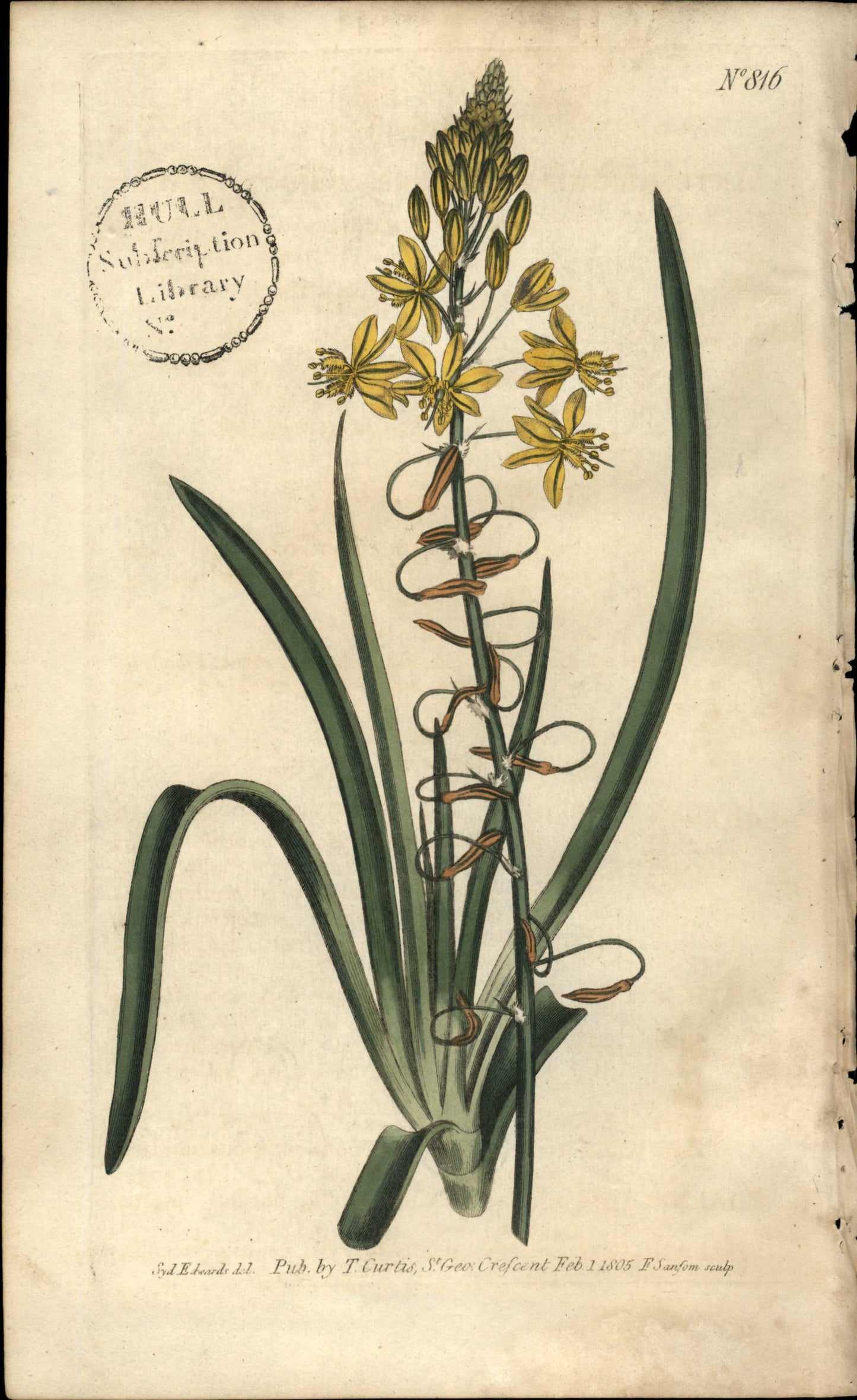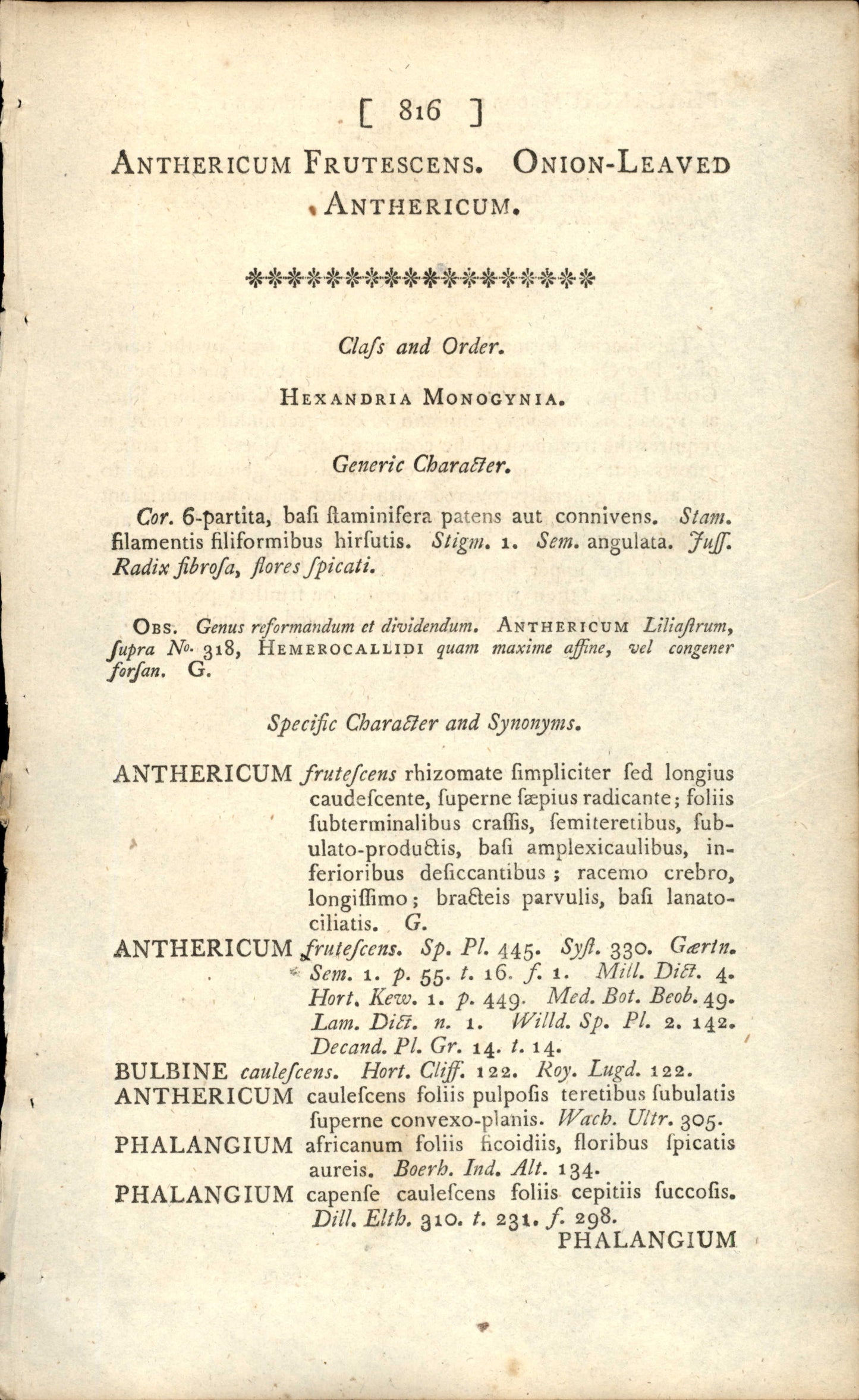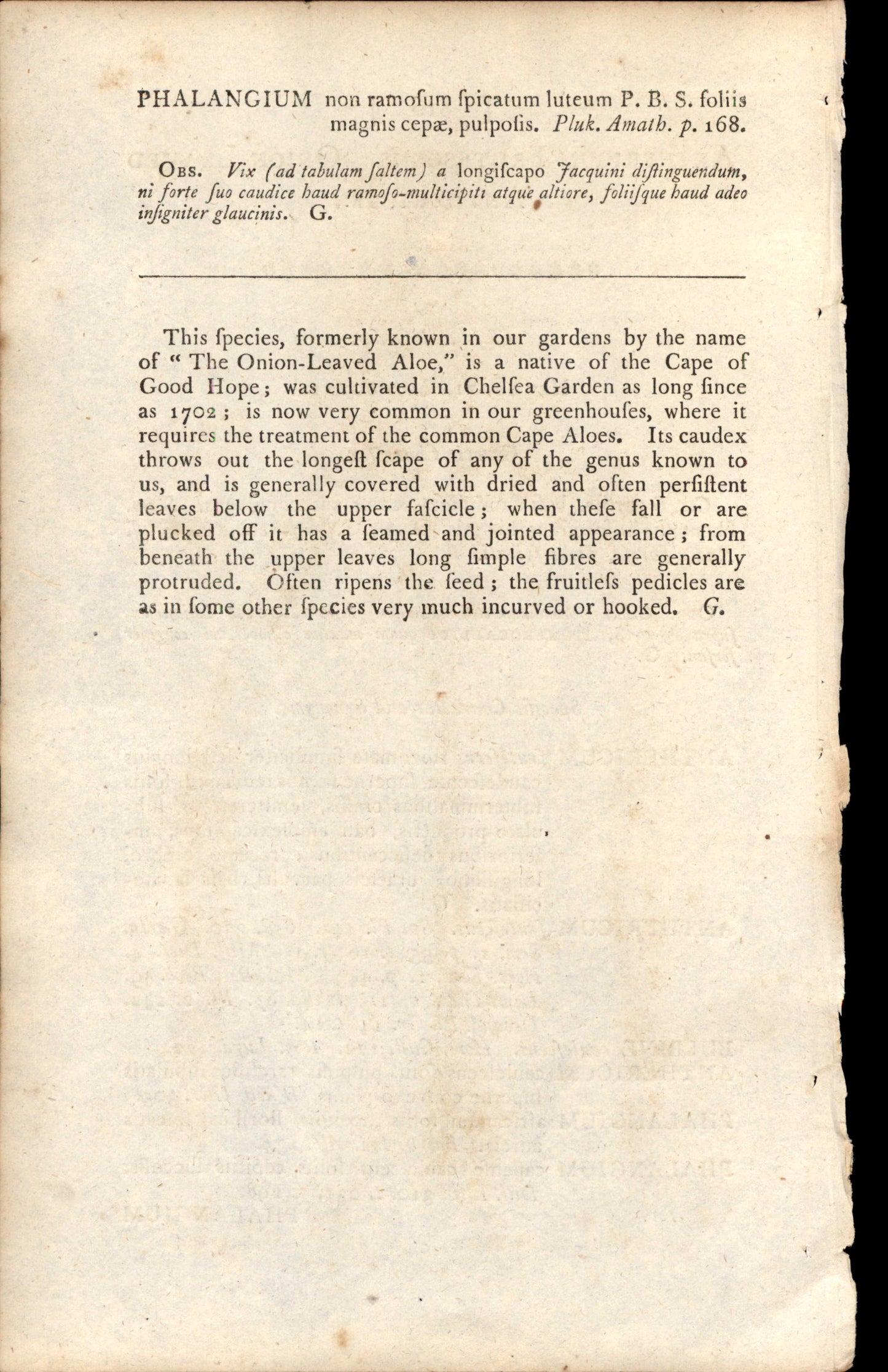Curtis Botanical Magazine
Plate 816 - Anthericum Frutescens
Plate 816 - Anthericum Frutescens
Couldn't load pickup availability
Plate 816
Classification: HEXANDRIA MONOGYNIA
Publication Date: 1805
Description:
Botanical Description
Onion-Leaved Aloe," is a native of the Cape of Good Hope; was cultivated in Chelfea Garden as long fince as 1702; is now very common in our greenhouses, where it requires the treatment of the common Cape Aloes. Its caudex throws out the longeft fcape of any of the genus known to us, and is generally covered with dried and often perfiftent leaves below the upper fafcicle; when thefe fall or are plucked off it has a feamed and jointed appearance; from beneath the upper leaves long fimple fibres are generally protruded. Often ripens the feed; the fruitless pedicles are as in some other species very much incurved or hooked. G.
Complete Botanical Text (Cleaned)
RULL subfcription Library N°816 syd Edwards del Pub. by T Curtis, sGeo: Crefcent Feb 1, 1805 FSansom sculp [ 816 ] ANTHERICUM FRUTEsCENS.
ONION-LEAVED ANTHERICUM. ****************** Class and Order.
HEXANDRIA MONOGYNIA.
Generic Character.
Cor. 6-partita, basi staminifera patens aut connivens. stam. filamentis filiformibus hirfutis. stigm. 1.
Sem. angulata.
Juff.
Radix fibrofa, flores fpicati.
OBS.
Genus reformandum et dividendum.
ANTHERICUM Liliaftrum, supra No. 318, HEMEROCALLIDI quam maxime affine, vel congener forfan.
G. specific Character and synonyms.
ANTHERICUM frutefcens rhizomate fimpliciter fed longius caudefcente, superne sæpius radicante; soliis fubterminalibus craffis, femiteretibus, fub- ulato-productis, basi amplexicaulibus, in- ferioribus deficcantibus; racemo crebro, longissimo; bractteis parvulis, basi lanato- ciliatis.
G.
ANTHERICUM frutefcens. sp.
Pl. 445. syst. 330.
Gartn.
Sem. 1. p. 55. t. 16. f. 1.
Mill.
Dict. 4.- Hort.
Kew. 1. p. 449.
Med.
Bot.
Beob. 49.
Lam.
Dict. n. 1.
Willd. sp.
Pl. 2. 142.
Decand.
Pl.
Gr. 14. t. 14.
BULBINE caulefcens.
Hort.
Cliff. 122.
Roy.
Lugd. 122.
ANTHERICUM caulefcens soliis pulpofis teretibus fubulatis superne convexo-planis.
Wach.
Ultr. 305.
PHALANGIUM africanum soliis ficoidiis, floribus spicatis aureis.
Boerh.
Ind.
Alt. 134.
PHALANGIUM capenfe caulefcens soliis cepitiis fuccofis.
Dill.
Elth. 310. t. 231. f. 298.
PHALANGIUM PHALANGIUM non ramofum spicatum luteum P.
B.
S. soliis magnis cepa, pulpofis.
Pluk.
Amath. p. 168.
OBS.
Vix (ad tabulam faltem) a longifcapo Jacquini diftinguendum, ni forte fuo caudice haud ramoso-multicipiti atque altiore, soliisque haud adeo infigniter glaucinis.
G.
This species, formerly known in our gardens by the name of "The Onion-Leaved Aloe," is a native of the Cape of Good Hope; was cultivated in Chelfea Garden as long since as 1702; is now very common in our greenhouses, where it requires the treatment of the common Cape Aloes.
Its caudex throws out the longest fcape of any of the genus known to us, and is generally covered with dried and often perfiftent leaves below the upper fafcicle; when these fall or are plucked off it has a feamed and jointed appearance; from beneath the upper leaves long simple fibres are generally protruded.
Often ripens the seed; the fruitless pedicles are as in some other species very much incurved or hooked.
G.
ALA
Raw OCR Text (Original)
RULL subfcription Library N°816 syd Edwards del Pub. by T Curtis, sGeo: Crefcent Feb 1, 1805 FSansom sculp [ 816 ] ANTHERICUM FRUTEsCENS. ONION-LEAVED ANTHERICUM. ****************** Class and Order. HEXANDRIA MONOGYNIA. Generic Character. Cor. 6-partita, basi staminifera patens aut connivens. stam. filamentis filiformibus hirfutis. stigm. 1. Sem. angulata. Juff. Radix fibrofa, flores fpicati. OBS. Genus reformandum et dividendum. ANTHERICUM Liliaftrum, supra No. 318, HEMEROCALLIDI quam maxime affine, vel congener forfan. G. specific Character and synonyms. ANTHERICUM frutefcens rhizomate fimpliciter fed longius caudefcente, superne sæpius radicante; soliis fubterminalibus craffis, femiteretibus, fub- ulato-productis, basi amplexicaulibus, in- ferioribus deficcantibus; racemo crebro, longissimo; bractteis parvulis, basi lanato- ciliatis. G. ANTHERICUM frutefcens. sp. Pl. 445. syst. 330. Gartn. Sem. 1. p. 55. t. 16. f. 1. Mill. Dict. 4.- Hort. Kew. 1. p. 449. Med. Bot. Beob. 49. Lam. Dict. n. 1. Willd. sp. Pl. 2. 142. Decand. Pl. Gr. 14. t. 14. BULBINE caulefcens. Hort. Cliff. 122. Roy. Lugd. 122. ANTHERICUM caulefcens soliis pulpofis teretibus fubulatis superne convexo-planis. Wach. Ultr. 305. PHALANGIUM africanum soliis ficoidiis, floribus spicatis aureis. Boerh. Ind. Alt. 134. PHALANGIUM capenfe caulefcens soliis cepitiis fuccofis. Dill. Elth. 310. t. 231. f. 298. PHALANGIUM PHALANGIUM non ramofum spicatum luteum P. B. S. soliis magnis cepa, pulpofis. Pluk. Amath. p. 168. OBS. Vix (ad tabulam faltem) a longifcapo Jacquini diftinguendum, ni forte fuo caudice haud ramoso-multicipiti atque altiore, soliisque haud adeo infigniter glaucinis. G. This species, formerly known in our gardens by the name of "The Onion-Leaved Aloe," is a native of the Cape of Good Hope; was cultivated in Chelfea Garden as long since as 1702; is now very common in our greenhouses, where it requires the treatment of the common Cape Aloes. Its caudex throws out the longest fcape of any of the genus known to us, and is generally covered with dried and often perfiftent leaves below the upper fafcicle; when these fall or are plucked off it has a feamed and jointed appearance; from beneath the upper leaves long simple fibres are generally protruded. Often ripens the seed; the fruitless pedicles are as in some other species very much incurved or hooked. G. ALA
Original botanical print from Curtis's Botanical Magazine
Share







